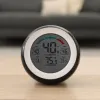Winter can be tough on your lungs, throat, eyes, and skin. Colder air doesn’t hold as much moisture as warmer air, so the relative humidity can get so low as to be very uncomfortable.
And the air inside your house can often be just as dry as the air outside. That’s no fun.
The first thing a lot of people do to increase humidity in their homes is to buy a tabletop humidifier. Some people even go all out and buy a whole-house humidifier that coexists with their duct system.
These solutions can work in certain situations — and we’ll consider all of them — but they’re not the best first step for giving your house a humidity boost.
As it turns out, the best way to combat dry air is to keep it out in the first place. Here’s our step-by-step guide to getting wintertime humidity to a comfortable level.
1. Seal the air leaks throughout your home
That dry air didn’t just materialize in your house on its own. It came in from the outdoors.
Air can leak into your home from all over the place. Most people immediately assume that the gaps around doors and windows are their largest sources of air leaks, but that’s often not the case. Those are just the most apparent sources of leakage because we spend a lot of time around doors and windows.
In most homes, the gaps and cracks between your living space and your ceiling, and crawlspace (or basement) are where most outdoor air enters your home.
These gaps and cracks are usually found where electrical wires, plumbing pipes, and HVAC ductwork enter and leave. Contractors and builders are good at cutting and drilling holes. They rarely plug the gaps around those holes, however, leading to a lifetime of air leaks and discomfort for homeowners.
Unless you seal those air leaks, of course.
So, how do you find where most of the dry, cold air is getting into your home? The best way is to book a home assessment, which includes a blower door test and thermal imaging analysis of your home.
We pressurize your home with a blower door device (it’s a fan that fits inside an open exterior door). While it’s running, we explore your home with an infrared camera to document thermal activity in every room. This helps us find the biggest areas of air leakage, so we can easily prioritize which ones to seal.
2. Add humidity passively
After sealing the leaks, you may no longer feel the need for exotic devices like humidifiers! Many people find that they passively generate enough humidity to stay comfortable through winter. That is, regular household activities like cooking, showering, and hanging clothes to dry are adding sufficient humidity to the air.
In a tightly air-sealed home, that humid air isn’t being replaced as often by dry, outdoor air. The occupants are more comfortable. No humidifier is needed.
Remember: a humidifier is usually a band-aid solution for a problem with your home.
If the home isn’t leaky and lets in lots of dry air, you usually won’t be concerned about humidity levels in winter. Also, sealing the leaks has the added benefit of keeping hot, humid air out during the summer!
3. Try a standalone humidifier
Everyone’s comfort threshold is different. Some people feel like the air is too dry in some rooms even after sealing up their homes. Most won’t, but some will.
If that’s your bedroom while you’re sleeping (a common place for the air to seem too dry — ever woken up with a scratchy throat in winter?), this is the point at which you get a little humidifier.
Put it on your bedside table at night. This is usually all you need to do to avoid the last step.
You may also consider an even larger standalone humidifier. There are floor humidifiers that can humidify up to 2,500 square feet of space and typically only need to be refilled every two or three days. These could be useful if you want to humidify a larger area of your home during the winter.
4. Get a whole-house humidifier
If you’ve felt like we’re trying to get you to avoid this step, you’re right!
At PV Heating, Cooling & Plumbing, we sell whole-house humidifiers and will happily install one if you insist. We just believe in solving the cause of the problem rather than just treating the symptoms. If we can solve your humidity problem by sealing air leaks — and this is often all that’s needed! — then that’s what we’d prefer to do.
That being said, whole-house humidifiers are a good solution for some people. They integrate with your HVAC system and can send just the right amount of humidity through the pipes.
Here are a few things to keep in mind if you opt for a whole-house humidifier:
- It’s best to have your installer use hard pipe trunk lines of the unit. You don’t want to risk putting much moisture into kinked ducts or, worse yet, duct boards. Water could collect there and encourage mold growth.
- Set your relative humidity between 40 and 50 RH at most. You don’t want to risk over-humidifying an already leaky home (assuming you didn’t air seal your home first) because the humidity could reach the cold building materials and lead to mold and rot inside your walls. Not good.
- Get a steam humidifier, not a bypass humidifier. Steam models boil water on their own, unlike a bypass model that takes the hot air from your duct supply to create water vapor. The steam type is more efficient.
If the dry winter air is driving you nuts…
We can help. If you live in Metro Atlanta and want to increase indoor humidity in winter (and decrease it in summer), get in touch with us! We’ll visit your home, learn about your concerns, and point you toward the best option.
In most cases, a home assessment to find air leaks is the best choice. But it all depends on you, your home, and your goals. That’s why we listen closely and always pursue a solution that you’re comfortable with.






